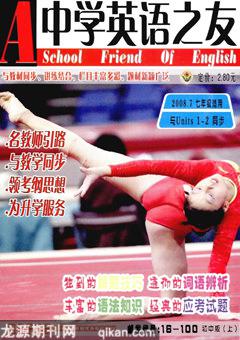“形容词性物主代词”的用法
李 锐
一、构成

二、使用方法
形容词性物主代词具有形容词作定语的特征,应放在名词前作定语修饰名词。始终要和名词连在一起,不能单独使用。例如:
Amy is my friend. 埃米是我的朋友。
Whats your name? 你叫什么名字?
注意:有时也可以在形容词性物主代词和名词之间加些形容词,提高使用效果。例如:
This is his red pencil. 这是他的红色铅笔。
三、注意事项
1.形容词性物主代词修饰名词时,不能和冠词或指示代词同用。这点千万要注意。例如:
This is my pencil. (√)
This is my a pencil.(×)
2.形容词性物主代词和名词组成短语作主语时,谓语动词应与该名词在数上保持一致。例如:
His rulers are yellow. 他的尺子是黄色的。
Your bike is nice. 你的自行车很漂亮。
3.汉语表达有省去“的”字的习惯,如:我妈妈、你们老师。其实,其中的“我”、“你们”的实际意义是“我的”、“你们的”。所以在译成英语时,必须使用相应的形容词性物主代词译成my mom, your teacher,而不能译成I mom, you teacher。例如:
你妈妈在家吗?
Is your mother at home? (√)
Is you mother at home? (×)
用适当的形容词性物主代词填空。
1. This is not ____ desk. My desk is over there.
2. ——Can you spell ____ name, Harry? ——Sorry.
3. Mrs Green is my teacher. I?蒺m ____ student.
4. Tom is in the room. This is ____ pencil?鄄box.
5. Sam and Peter, look at ____ hands. They are so dirty.
6. ——Mike, is this ____ picture? ——Yes, it is.
7. Mum, they are ____ classmates, Rose and ____ brother David.
8. Jack, where are ____ socks?
答案:1.my2.your3.her4.his5.your6.your7.my, her8.your

